外研高二选修8 Module 3 Foreign Food模块复习课件(49张)
文档属性
| 名称 | 外研高二选修8 Module 3 Foreign Food模块复习课件(49张) | 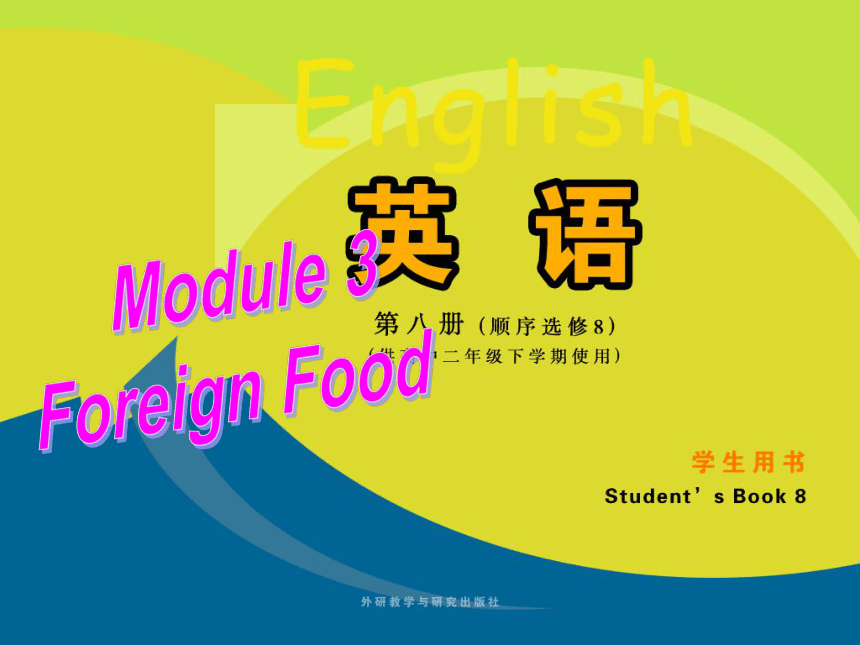 | |
| 格式 | zip | ||
| 文件大小 | 556.0KB | ||
| 资源类型 | 教案 | ||
| 版本资源 | 外研版 | ||
| 科目 | 英语 | ||
| 更新时间 | 2017-01-18 19:57:14 | ||
图片预览


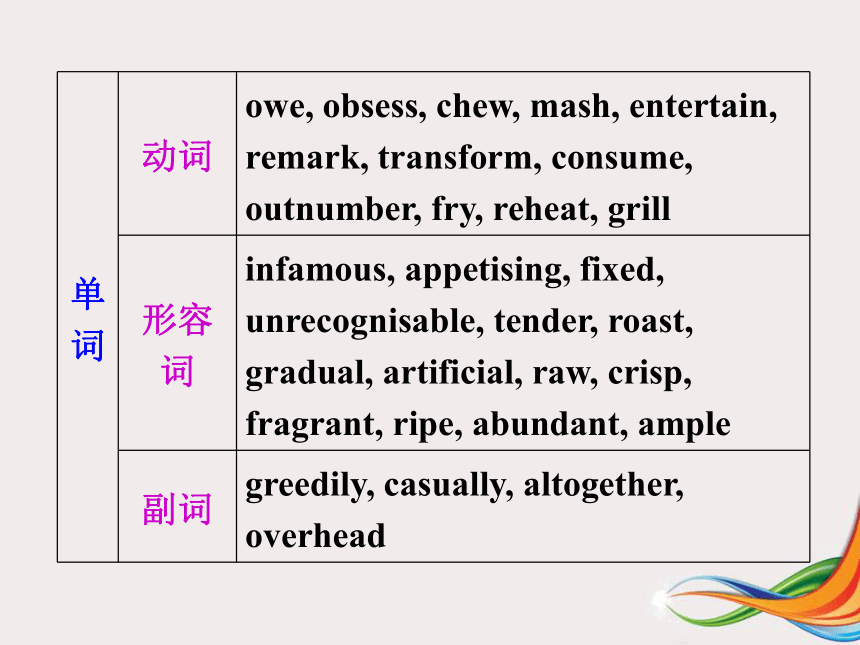
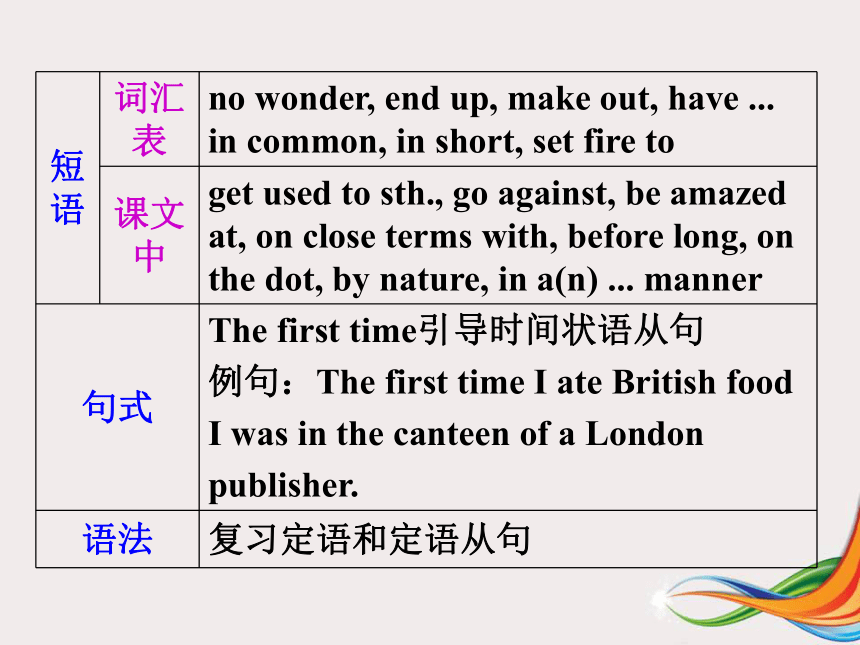
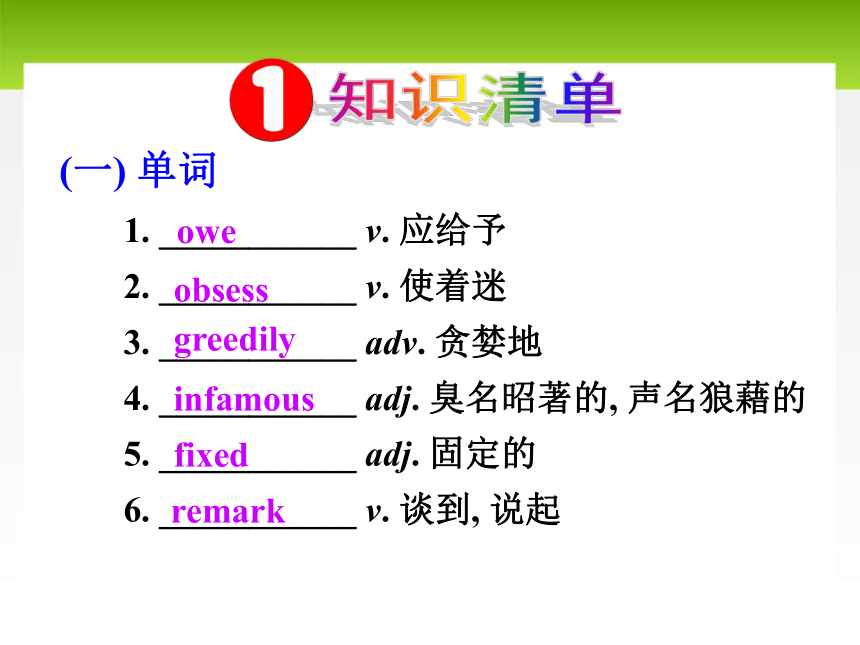
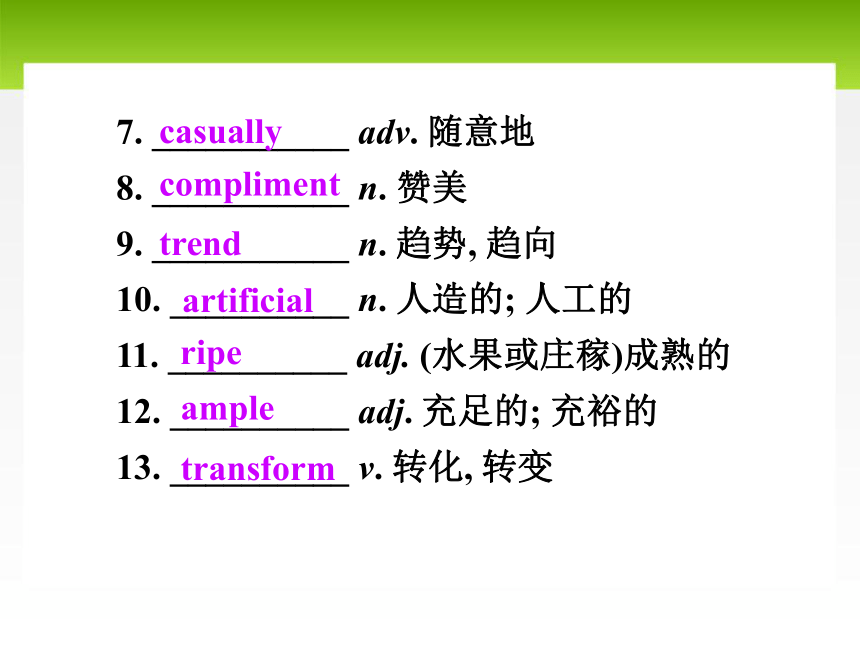
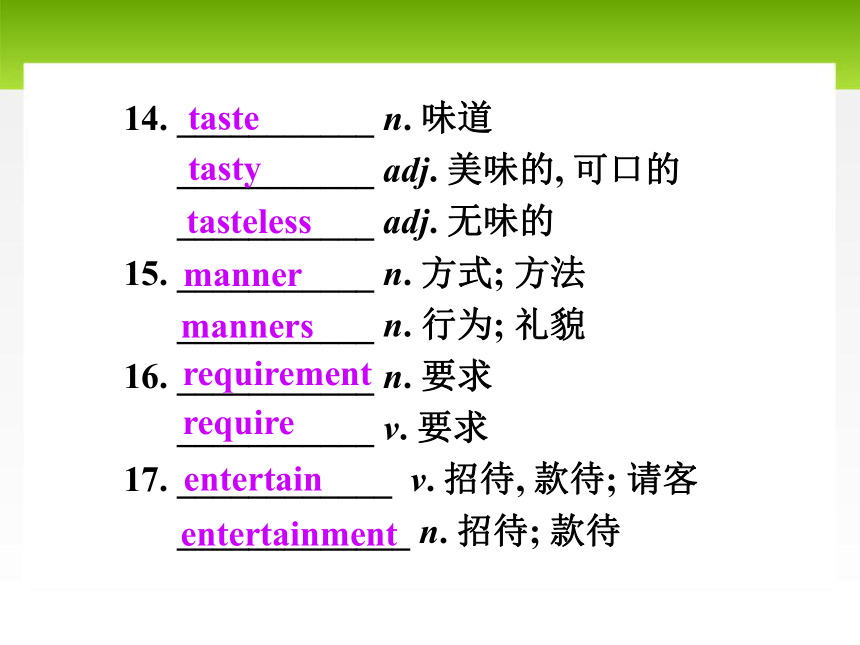
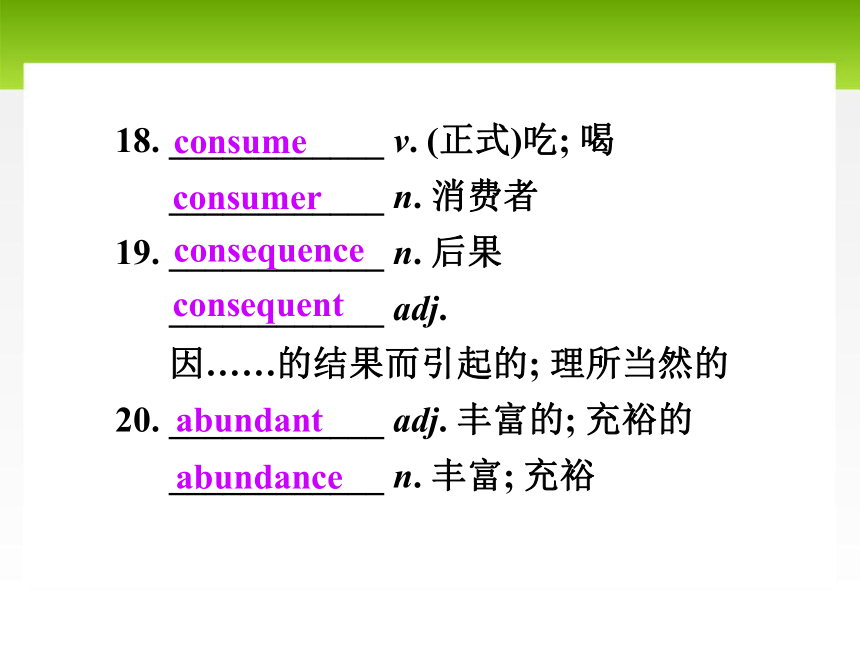
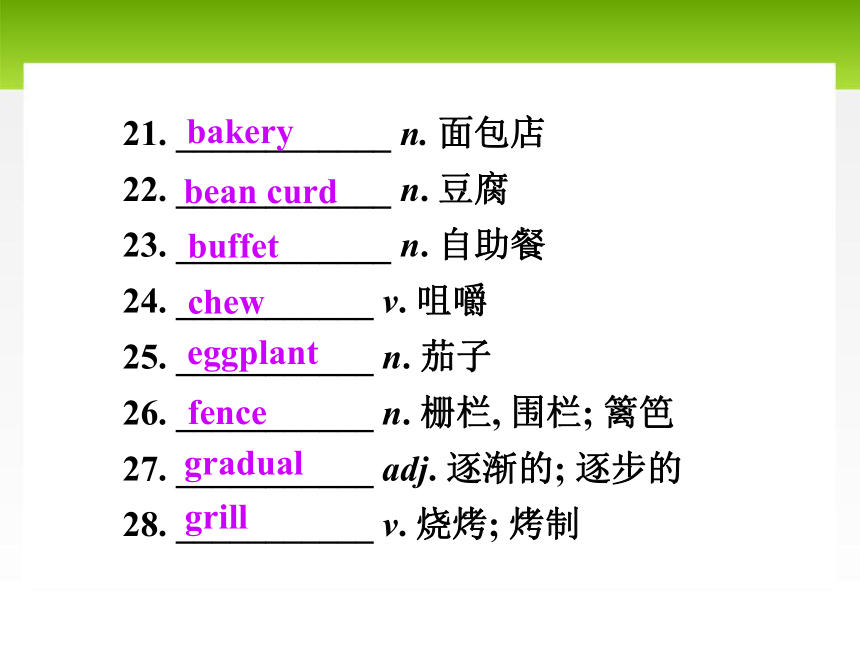
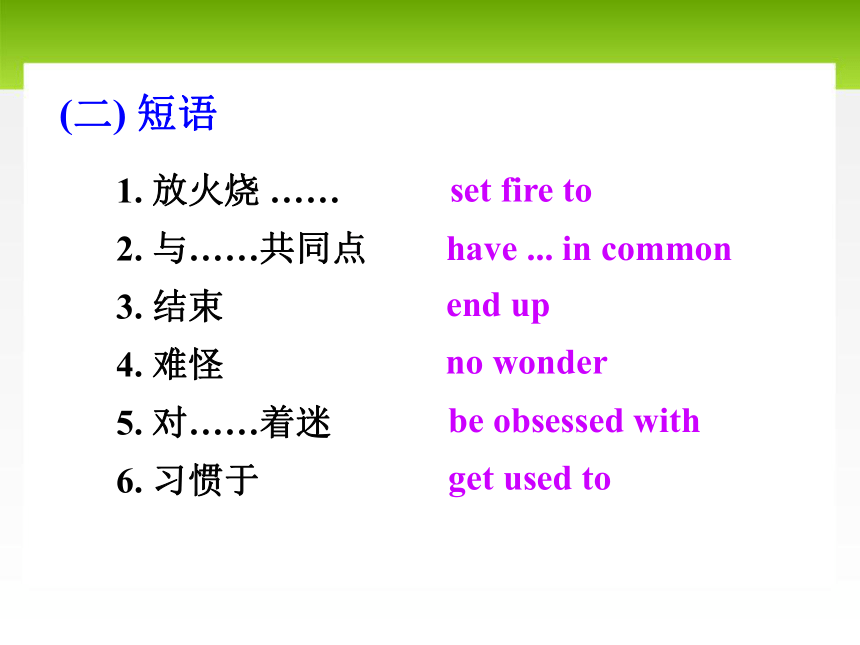
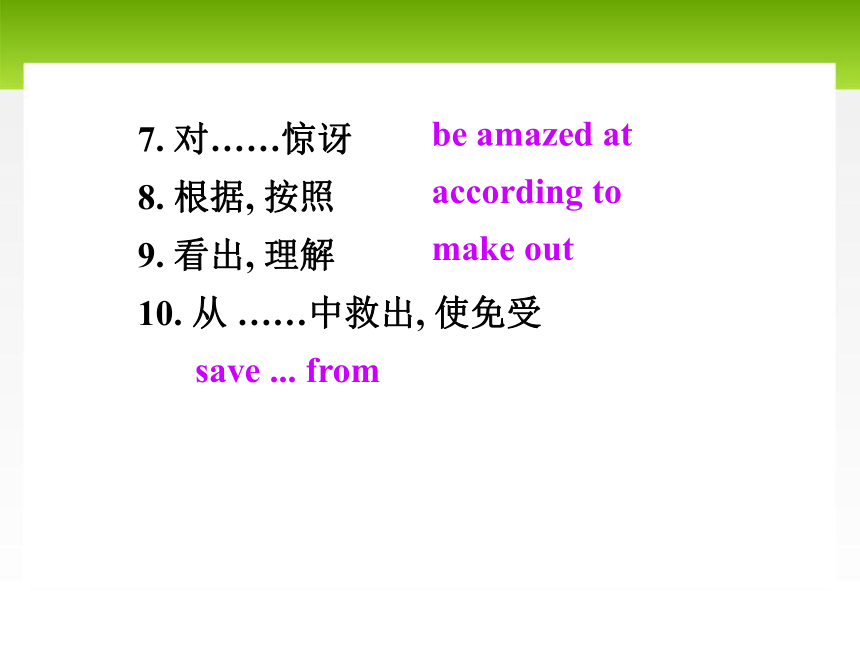
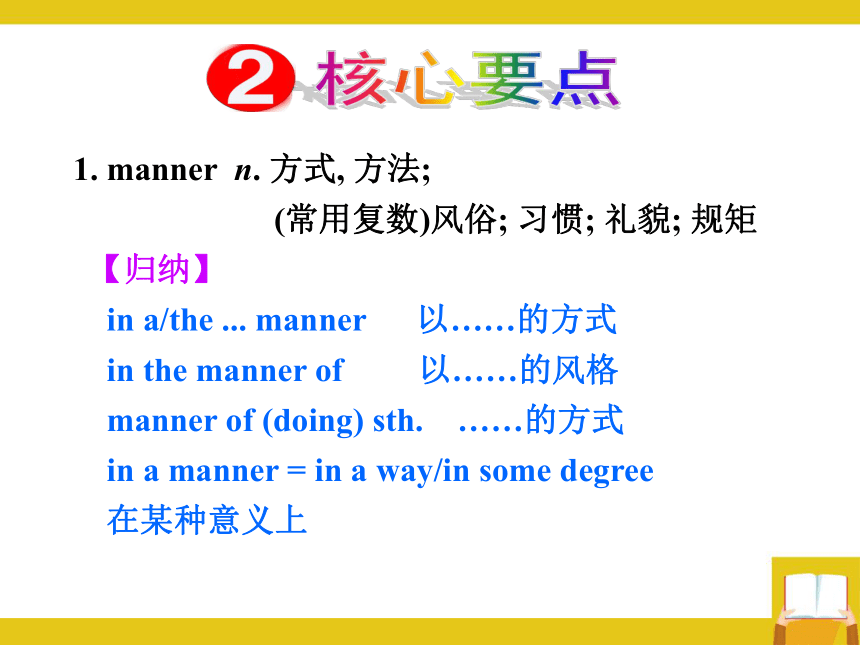
文档简介
课件49张PPT。Module 3
Foreign Food知识归纳1. ___________ v. 应给予
2. ___________ v. 使着迷
3. ___________ adv. 贪婪地
4. ___________ adj. 臭名昭著的, 声名狼藉的
5. ___________ adj. 固定的
6. ___________ v. 谈到, 说起知识清单(一) 单词oweobsessgreedilyinfamousfixedremark7. ___________ adv. 随意地
8. ___________ n. 赞美
9. ___________ n. 趋势, 趋向
10. __________ n. 人造的; 人工的
11. __________ adj. (水果或庄稼)成熟的
12. __________ adj. 充足的; 充裕的
13. __________ v. 转化, 转变casuallycomplimenttrendartificialripeampletransform14. ___________ n. 味道
___________ adj. 美味的, 可口的
___________ adj. 无味的
15. ___________ n. 方式; 方法
___________ n. 行为; 礼貌
16. ___________ n. 要求
___________ v. 要求
17. ____________ v. 招待, 款待; 请客
_____________ n. 招待; 款待tastetastytastelessmannermannersrequirementrequireentertainentertainment18. ____________ v. (正式)吃; 喝
____________ n. 消费者
19. ____________ n. 后果
____________ adj.
因……的结果而引起的; 理所当然的
20. ____________ adj. 丰富的; 充裕的
____________ n. 丰富; 充裕
consumeconsumerconsequenceconsequentabundantabundance21. ____________ n. 面包店
22. ____________ n. 豆腐
23. ____________ n. 自助餐
24. ___________ v. 咀嚼
25. ___________ n. 茄子
26. ___________ n. 栅栏, 围栏; 篱笆
27. ___________ adj. 逐渐的; 逐步的
28. ___________ v. 烧烤; 烤制bakerybean curdbuffetcheweggplantfencegradualgrill1. 放火烧 ……
2. 与……共同点
3. 结束
4. 难怪
5. 对……着迷
6. 习惯于(二) 短语set fire tohave ... in commonend upno wonderbe obsessed withget used to7. 对……惊讶
8. 根据, 按照
9. 看出, 理解
10. 从 ……中救出, 使免受be amazed ataccording tomake outsave ... from1. manner n. 方式, 方法;
(常用复数)风俗; 习惯; 礼貌; 规矩
【归纳】
in a/the ... manner 以……的方式
in the manner of 以……的风格
manner of (doing) sth. ……的方式
in a manner = in a way/in some degree
在某种意义上核心要点2. consequence n. 后果, 结果;
影响(需用复数形式); 重要性
【归纳】
as a consequence 结果
in consequence of 由于; 作为……的结果
suffer/face/take the consequences
自食其果; 面对/承担自己行动的后果
【拓展】
consequent adj. 随之发生的; 作为结果的
consequently adv. 因此; 所以3. transform v. 改变, 改造; 使改观; 使转化
【归纳】
transform ... into ... 把……改变成……
transform sb./sth. from ... 从……中转变
【拓展】
transformation n. 转化, 改变
transformation from sth. to sth.
从……到……的转变
transformer n. 变压器4. owe v. 欠(账、钱、人情等); 归功于……
【归纳】
owe sb. sth./owe sth. to sb. 欠某人某物
owe...to... 把……归功于……
owe it to sb. that... 多亏某人……
【拓展】
owing adj. 欠着的; 未付的
owing to = because of 因为, 由于5. taste n. 味道; 味觉; 口味; 爱好; 趣味
v. 品尝
link-v. 尝起来……
【归纳】
have a taste of 尝一尝, 领略
have taste in 对……有鉴赏力
to one’s taste 投合某人的爱好
【拓展】
表示感官的系动词还有smell(闻起来), feel(摸起
来), look(看起来), sound(听起来)等。后面常跟形
容词作表语, 表示主语的性质; 也可以跟like+n.,
表示“像……”的意思。6. remark n. 评论; 意见
v. 谈到; 说起; 评论
【归纳】
remark on sb./sth. 评论, 谈论
remark on/upon
对……发表看法, 评论
make a remark 评论7. consequence n. 结果; 后果; 重要性
【归纳】
take/accept the consequences of
承担……的后果
as a consequence = in consequence
因此, 结果
as a consequence of = in consequence of
由于…… 的原因
of no/little consequence to sb.
对……无关紧要8. no wonder 难怪
【归纳】
It’s no wonder (that).../No wonder (that)...
难怪……
It’s a wonder (that)… 奇怪的是……
It’s little/small wonder that... 对……不足为奇
do wonders 创造奇迹
wonder at/about (doing) sth.
对……好奇; 想知道……
wonder+if/whether+clause 不知道能否……9. make out 看出, 听出, 理解; 开出, 填写;
辨认出; 声称, 断言
【拓展】
make...out of... 把……改成, 用……做成
make up for 弥补, 补偿
make fun of 取笑
make a difference 有关系, 有影响
make it 做成; 成功10. have ... in common 与……有共同点
【拓展】
have nothing in common with
与……无共同之处
in common 共同的; 共有的
in common with 和……相同(多作状语)
out of (the) common 不寻常的; 特殊的
common sense 常识I. 根据本模块所学单词及提示写出所缺单词的正确形式。
1. When I asked him to pay me what he ______ (欠债), he got angry with me.
2. I don’t object to what she says, but I strongly disapprove of her ________ (方式) of saying it.manner? owed ?3. Experience in a related field is a(n) ____________ (要求) for this job.
4. She used to be terribly shy, but a year abroad has completely t____________ her.
5. Those bananas aren’t r____ yet — they’re still green.riperequirement?transformedII. 根据括号内的提示翻译下列句子。
我不明白他在说什么。(make out)
I couldn’t make out what he was saying.
2. 这两种文化具有很多相同之处。(have ...
in common)
The two cultures have a lot in common.
3. 你所做的事与你父母的愿望相反。(go
against)
What you have done goes against your
parents’ wishes.1. The first time I saw a three-year-old kid
cheerfully chewing a chicken’s head I had bad dreams for weeks.
我第一次看到一个3岁的小孩欢快地嚼着一个鸡头后, 连续几周都做噩梦。
the first time为名词词组, 经此处相当于连词, 引导时间状语从句, 可译为“第一次……”。句式有类似用法的还有: the day/moment/minute,
instantly/immediately等。如:
The first time he was there, he received a warm welcome by the villagers.
他第一次到达那儿的时候就受到了村民们的热情欢迎。
He said he would inform me the moment he arrived in Beijing.
他说他一到北京就通知我。for the first time/the first timefor the first time 表示有生以来第一次做某事, 在句子中作状语。
the first time 相当于一个连词, 常引导一个时状语从句, 其重点是叙述某一动作或情况, 不是强调第一次做了什么事。另外, 它还可以做表语, 后接定语从句, 定语从句常用完成时态。2. It seemed to be just a bowl of grey liquid and it was only after I had tasted it that I knew it was actually cooked with mushrooms.
看上去那只是一碗灰色的汤, 我尝了一下后才知道那实际上是用蘑菇做的。
句中it was … that …是强调句结构, 被强调部分是时间状语only after…。 It 引导的强调句结构为: It is/was + 被强调部分 + that/who + 句子其他部分。如:
It was only after my friend came that the computer was repaired.
It was only after careful consideration that he put forward his views.语法非限制性定语从句高考考点解读考点一、关系代词引导的非限制性定语从句
【真题再现】
1. I borrowed the book Sherlock Holmes from the library last week, _____ my classmates recommended to me.? (2014年北京卷单项填空)
A. who??? ??? B. which???? ? C. when??? ?? D. where2. I wish to thank Professor Smith, without _____ help I would never have got this far. (2012年天津卷单项填空)
A. who ? ??????B. whose??? ? C. whom ?????? D. which
3. After the flooding, people were suffering in that area, _____ urgently needed clean water, medicine and shelter to survive.? (2012年江苏卷单项填空)
A. which???????? B. who??????? C. where??????? D. what 4. _____ is often the case with children, Amy was better by the time the doctor arrived.?(2013年陕西卷单项填空)
A. It ? ? ? ? ? ? ? B. That ? ? ? ? ?C. What ? ? ? ? D. As【考点解读】非限制性定语从句不能用that引导,先行词指物时可用which和whose引导,指人时可用who, whom, whose引导。另外,非限制性定语从句还可用as引导。在题1中,设空处引导非限制性定语从句,补充说明先行词the book Sherlock Holmes,且在从句中作宾语,故选which。在题2中, 设空处引导非限制性定语从句, 补充说明先行词Professor Smith, 且在从句中作help的定语, 故选whose。在题3中, 设空处引导非限制性定语从句, 补充说明先行词people, 且在从句中作主语, 故选who。在题4中, 设空处引导非限制定语从句, 指代整个主句的内容, 故选As。
注意:
1. which和as在非限制性定语从句中,可以指代主句或主句中的一部分,而在限制性定语从句中只可指代先行词。
2. as所引导的非限制性定语从句可以放在句首、句中或句末,而which所引导的非限制性定语从句只可以放在句末。考点二、关系副词引导的非限制性定语从句
【真题再现】
1. I didn’t become a serious climber until the fifth grade, _____ I went up to rescue a kite that was stuck in the branches of a tree. (2014年浙江卷单项填空)
A. when?????? B. where????? C. which????? ?D. why
2. Whatever is left over may be put into the refrigerator, _____ it will keep for two or three weeks. (2011年安徽卷单项填空)
A. when?????? B. which?????? C. where???? D. while【考点解读】
引导非限制性定语从句的关系副词有when, where, why等, 在从句中作时间、地点、原因等状语。在题1中, 设空处引导非限制性定语从句,补充说明先行词the fifth grade, 且在从句中作时间状语, 故选when。在题2中, 设空处引导非限制性定语从句, 补充说明先行词refrigerator, 且在从句中作地点状语,故选where。考点三、“介词+关系代词”引导的非限制性定语从句
【真题再现】
1. She showed the visitors around the museum, the construction _____ had taken more than three years. (2011年江西卷单项填空)
A. for which???? ?????? ? B. with which???????
C. of which?????????????? ? D. to which
2. In our class there are 46 students, _____ half wear glasses.??? ?(2012年四川卷单项填空)
A. in whom ? ? ? ? ? ? ? ?B. in them??????
C. of whom?????????? ?????? D. of them【考点解读】
介词放在关系代词之前时, 关系代词只能用which(指物)或whom(指人), 介词的选择要视先行词、句意及与动词的搭配而定。在题1中, 设空处引导非限制性定语从句, 补充说明先行词the museum, 且由the construction of the museum可知应选of which。在题2中, 设空处引导非限制性定语从句, 补充说明先行词students, 且half与students之间是所属关系, 故选of whom。用适当的关系词或“介词+关系代词”填空。
I just read a book called TechnoStress, 1. ______ was written by Dr. Michelle M. Weil. Her co-author was Dr. Larry Rosen, 2. _____ is her husband and also a psychologist. According to the authors, everybody feels stressed about technology. Our cell phones, 3. ______ we buy for whichwhich? who??emergencies, soon invade our privacy. Just because they can, people contact us at places 4. _______ we are relaxing. Another problem 5. _________ we are facing is that we have to learn too much too fast. Technological changes, 6. _______ used to come one at a time, now overwhelm (淹没) us. Dr. Weil suggests that we read her latest book, 7. ____ _______ we can turn in dealing with technostress. It can be purchased from her website.whichwhere?that/which?which?to写作【写作任务】
???请你根据所给提示,用英语写一篇短文,介绍你第一次吃西餐的经历。如何用英语写一次饮食方面的经历注意: 1. 词数120左右;
2. 可适当增加细节,以使行文连贯。【写作指导】
审题定调:
?????? 本写作要求描写第一次吃西餐的经历,属 于记叙文。人称以第一人称为主,时态以一般过去时为主。
布局谋篇:
全文可分为三部分:
第一部分:开门见山,点明主题;
第二部分:具体叙述第一次吃西餐的情况;
第三部分:自己的感受。常用表达:
Western food
a knife and fork
I will never forget my experience of ...
It was the first time that I ..., so ...
What made me more embarrassed was that ...
You can’t imagine ...
That experience made me realize that ...【参考范文】
I will never forget my experience of trying Western food for the first time two years ago.
My foreign language teacher invited me to his home for dinner. It was the first time that I had tried Western food, so I didn’t know how to use a knife and fork. I held the knife with my left hand and even picked up the food with it. Seeing this, my teacher taught me the correct way to use aknife and fork. What made me more embarrassed was that I wiped off some sweat with a napkin which should only be used to wipe mouths in western countries. You can’t imagine how embarrassed I was then.
That experience made me realize that knowing the difference between different cultures is important.巩固练习阅读下面材料, 在空白处填入适当的内容(不多于3个单词)或括号内单词的正确形式。
“Jambalaya, Crawfish Pie and Fillet Gumbo,” appear in the chorus of country artist Hank Williams’ much recorded song On the Bayou. He was listing three of the most famous and popular dishes 1. _________ (consume) in the southern state of Louisiana in the USA. consumedJambalaya, Crawfish Pie and Fillet Gumbo are
Louisiana Creole dishes of Spanish and French origin, 2. ________ customers will find on the menus of restaurants all over Louisiana. In the 18th century, French and Spanish settlers in Louisiana were known 3. ______ Creoles. Creole cuisine is 4. ________ (heavy) seasoned with some sort of pepper and tastes very spicy. Jambalaya is 5. ____ rice-based dish that cana?which?asheavilycontain shrimp, sausages, or oysters. Crawfish pie 6. ________ (contain) crawfish or crayfish, onions and celery. Although recipes vary, Gumbo is a soup usually made 7. _______ bell peppers, onions, celery and seafood or chicken and sausages. 8. _____ is stewed (炖) all day and served over rice.Itcontains? from?
Foreign Food知识归纳1. ___________ v. 应给予
2. ___________ v. 使着迷
3. ___________ adv. 贪婪地
4. ___________ adj. 臭名昭著的, 声名狼藉的
5. ___________ adj. 固定的
6. ___________ v. 谈到, 说起知识清单(一) 单词oweobsessgreedilyinfamousfixedremark7. ___________ adv. 随意地
8. ___________ n. 赞美
9. ___________ n. 趋势, 趋向
10. __________ n. 人造的; 人工的
11. __________ adj. (水果或庄稼)成熟的
12. __________ adj. 充足的; 充裕的
13. __________ v. 转化, 转变casuallycomplimenttrendartificialripeampletransform14. ___________ n. 味道
___________ adj. 美味的, 可口的
___________ adj. 无味的
15. ___________ n. 方式; 方法
___________ n. 行为; 礼貌
16. ___________ n. 要求
___________ v. 要求
17. ____________ v. 招待, 款待; 请客
_____________ n. 招待; 款待tastetastytastelessmannermannersrequirementrequireentertainentertainment18. ____________ v. (正式)吃; 喝
____________ n. 消费者
19. ____________ n. 后果
____________ adj.
因……的结果而引起的; 理所当然的
20. ____________ adj. 丰富的; 充裕的
____________ n. 丰富; 充裕
consumeconsumerconsequenceconsequentabundantabundance21. ____________ n. 面包店
22. ____________ n. 豆腐
23. ____________ n. 自助餐
24. ___________ v. 咀嚼
25. ___________ n. 茄子
26. ___________ n. 栅栏, 围栏; 篱笆
27. ___________ adj. 逐渐的; 逐步的
28. ___________ v. 烧烤; 烤制bakerybean curdbuffetcheweggplantfencegradualgrill1. 放火烧 ……
2. 与……共同点
3. 结束
4. 难怪
5. 对……着迷
6. 习惯于(二) 短语set fire tohave ... in commonend upno wonderbe obsessed withget used to7. 对……惊讶
8. 根据, 按照
9. 看出, 理解
10. 从 ……中救出, 使免受be amazed ataccording tomake outsave ... from1. manner n. 方式, 方法;
(常用复数)风俗; 习惯; 礼貌; 规矩
【归纳】
in a/the ... manner 以……的方式
in the manner of 以……的风格
manner of (doing) sth. ……的方式
in a manner = in a way/in some degree
在某种意义上核心要点2. consequence n. 后果, 结果;
影响(需用复数形式); 重要性
【归纳】
as a consequence 结果
in consequence of 由于; 作为……的结果
suffer/face/take the consequences
自食其果; 面对/承担自己行动的后果
【拓展】
consequent adj. 随之发生的; 作为结果的
consequently adv. 因此; 所以3. transform v. 改变, 改造; 使改观; 使转化
【归纳】
transform ... into ... 把……改变成……
transform sb./sth. from ... 从……中转变
【拓展】
transformation n. 转化, 改变
transformation from sth. to sth.
从……到……的转变
transformer n. 变压器4. owe v. 欠(账、钱、人情等); 归功于……
【归纳】
owe sb. sth./owe sth. to sb. 欠某人某物
owe...to... 把……归功于……
owe it to sb. that... 多亏某人……
【拓展】
owing adj. 欠着的; 未付的
owing to = because of 因为, 由于5. taste n. 味道; 味觉; 口味; 爱好; 趣味
v. 品尝
link-v. 尝起来……
【归纳】
have a taste of 尝一尝, 领略
have taste in 对……有鉴赏力
to one’s taste 投合某人的爱好
【拓展】
表示感官的系动词还有smell(闻起来), feel(摸起
来), look(看起来), sound(听起来)等。后面常跟形
容词作表语, 表示主语的性质; 也可以跟like+n.,
表示“像……”的意思。6. remark n. 评论; 意见
v. 谈到; 说起; 评论
【归纳】
remark on sb./sth. 评论, 谈论
remark on/upon
对……发表看法, 评论
make a remark 评论7. consequence n. 结果; 后果; 重要性
【归纳】
take/accept the consequences of
承担……的后果
as a consequence = in consequence
因此, 结果
as a consequence of = in consequence of
由于…… 的原因
of no/little consequence to sb.
对……无关紧要8. no wonder 难怪
【归纳】
It’s no wonder (that).../No wonder (that)...
难怪……
It’s a wonder (that)… 奇怪的是……
It’s little/small wonder that... 对……不足为奇
do wonders 创造奇迹
wonder at/about (doing) sth.
对……好奇; 想知道……
wonder+if/whether+clause 不知道能否……9. make out 看出, 听出, 理解; 开出, 填写;
辨认出; 声称, 断言
【拓展】
make...out of... 把……改成, 用……做成
make up for 弥补, 补偿
make fun of 取笑
make a difference 有关系, 有影响
make it 做成; 成功10. have ... in common 与……有共同点
【拓展】
have nothing in common with
与……无共同之处
in common 共同的; 共有的
in common with 和……相同(多作状语)
out of (the) common 不寻常的; 特殊的
common sense 常识I. 根据本模块所学单词及提示写出所缺单词的正确形式。
1. When I asked him to pay me what he ______ (欠债), he got angry with me.
2. I don’t object to what she says, but I strongly disapprove of her ________ (方式) of saying it.manner? owed ?3. Experience in a related field is a(n) ____________ (要求) for this job.
4. She used to be terribly shy, but a year abroad has completely t____________ her.
5. Those bananas aren’t r____ yet — they’re still green.riperequirement?transformedII. 根据括号内的提示翻译下列句子。
我不明白他在说什么。(make out)
I couldn’t make out what he was saying.
2. 这两种文化具有很多相同之处。(have ...
in common)
The two cultures have a lot in common.
3. 你所做的事与你父母的愿望相反。(go
against)
What you have done goes against your
parents’ wishes.1. The first time I saw a three-year-old kid
cheerfully chewing a chicken’s head I had bad dreams for weeks.
我第一次看到一个3岁的小孩欢快地嚼着一个鸡头后, 连续几周都做噩梦。
the first time为名词词组, 经此处相当于连词, 引导时间状语从句, 可译为“第一次……”。句式有类似用法的还有: the day/moment/minute,
instantly/immediately等。如:
The first time he was there, he received a warm welcome by the villagers.
他第一次到达那儿的时候就受到了村民们的热情欢迎。
He said he would inform me the moment he arrived in Beijing.
他说他一到北京就通知我。for the first time/the first timefor the first time 表示有生以来第一次做某事, 在句子中作状语。
the first time 相当于一个连词, 常引导一个时状语从句, 其重点是叙述某一动作或情况, 不是强调第一次做了什么事。另外, 它还可以做表语, 后接定语从句, 定语从句常用完成时态。2. It seemed to be just a bowl of grey liquid and it was only after I had tasted it that I knew it was actually cooked with mushrooms.
看上去那只是一碗灰色的汤, 我尝了一下后才知道那实际上是用蘑菇做的。
句中it was … that …是强调句结构, 被强调部分是时间状语only after…。 It 引导的强调句结构为: It is/was + 被强调部分 + that/who + 句子其他部分。如:
It was only after my friend came that the computer was repaired.
It was only after careful consideration that he put forward his views.语法非限制性定语从句高考考点解读考点一、关系代词引导的非限制性定语从句
【真题再现】
1. I borrowed the book Sherlock Holmes from the library last week, _____ my classmates recommended to me.? (2014年北京卷单项填空)
A. who??? ??? B. which???? ? C. when??? ?? D. where2. I wish to thank Professor Smith, without _____ help I would never have got this far. (2012年天津卷单项填空)
A. who ? ??????B. whose??? ? C. whom ?????? D. which
3. After the flooding, people were suffering in that area, _____ urgently needed clean water, medicine and shelter to survive.? (2012年江苏卷单项填空)
A. which???????? B. who??????? C. where??????? D. what 4. _____ is often the case with children, Amy was better by the time the doctor arrived.?(2013年陕西卷单项填空)
A. It ? ? ? ? ? ? ? B. That ? ? ? ? ?C. What ? ? ? ? D. As【考点解读】非限制性定语从句不能用that引导,先行词指物时可用which和whose引导,指人时可用who, whom, whose引导。另外,非限制性定语从句还可用as引导。在题1中,设空处引导非限制性定语从句,补充说明先行词the book Sherlock Holmes,且在从句中作宾语,故选which。在题2中, 设空处引导非限制性定语从句, 补充说明先行词Professor Smith, 且在从句中作help的定语, 故选whose。在题3中, 设空处引导非限制性定语从句, 补充说明先行词people, 且在从句中作主语, 故选who。在题4中, 设空处引导非限制定语从句, 指代整个主句的内容, 故选As。
注意:
1. which和as在非限制性定语从句中,可以指代主句或主句中的一部分,而在限制性定语从句中只可指代先行词。
2. as所引导的非限制性定语从句可以放在句首、句中或句末,而which所引导的非限制性定语从句只可以放在句末。考点二、关系副词引导的非限制性定语从句
【真题再现】
1. I didn’t become a serious climber until the fifth grade, _____ I went up to rescue a kite that was stuck in the branches of a tree. (2014年浙江卷单项填空)
A. when?????? B. where????? C. which????? ?D. why
2. Whatever is left over may be put into the refrigerator, _____ it will keep for two or three weeks. (2011年安徽卷单项填空)
A. when?????? B. which?????? C. where???? D. while【考点解读】
引导非限制性定语从句的关系副词有when, where, why等, 在从句中作时间、地点、原因等状语。在题1中, 设空处引导非限制性定语从句,补充说明先行词the fifth grade, 且在从句中作时间状语, 故选when。在题2中, 设空处引导非限制性定语从句, 补充说明先行词refrigerator, 且在从句中作地点状语,故选where。考点三、“介词+关系代词”引导的非限制性定语从句
【真题再现】
1. She showed the visitors around the museum, the construction _____ had taken more than three years. (2011年江西卷单项填空)
A. for which???? ?????? ? B. with which???????
C. of which?????????????? ? D. to which
2. In our class there are 46 students, _____ half wear glasses.??? ?(2012年四川卷单项填空)
A. in whom ? ? ? ? ? ? ? ?B. in them??????
C. of whom?????????? ?????? D. of them【考点解读】
介词放在关系代词之前时, 关系代词只能用which(指物)或whom(指人), 介词的选择要视先行词、句意及与动词的搭配而定。在题1中, 设空处引导非限制性定语从句, 补充说明先行词the museum, 且由the construction of the museum可知应选of which。在题2中, 设空处引导非限制性定语从句, 补充说明先行词students, 且half与students之间是所属关系, 故选of whom。用适当的关系词或“介词+关系代词”填空。
I just read a book called TechnoStress, 1. ______ was written by Dr. Michelle M. Weil. Her co-author was Dr. Larry Rosen, 2. _____ is her husband and also a psychologist. According to the authors, everybody feels stressed about technology. Our cell phones, 3. ______ we buy for whichwhich? who??emergencies, soon invade our privacy. Just because they can, people contact us at places 4. _______ we are relaxing. Another problem 5. _________ we are facing is that we have to learn too much too fast. Technological changes, 6. _______ used to come one at a time, now overwhelm (淹没) us. Dr. Weil suggests that we read her latest book, 7. ____ _______ we can turn in dealing with technostress. It can be purchased from her website.whichwhere?that/which?which?to写作【写作任务】
???请你根据所给提示,用英语写一篇短文,介绍你第一次吃西餐的经历。如何用英语写一次饮食方面的经历注意: 1. 词数120左右;
2. 可适当增加细节,以使行文连贯。【写作指导】
审题定调:
?????? 本写作要求描写第一次吃西餐的经历,属 于记叙文。人称以第一人称为主,时态以一般过去时为主。
布局谋篇:
全文可分为三部分:
第一部分:开门见山,点明主题;
第二部分:具体叙述第一次吃西餐的情况;
第三部分:自己的感受。常用表达:
Western food
a knife and fork
I will never forget my experience of ...
It was the first time that I ..., so ...
What made me more embarrassed was that ...
You can’t imagine ...
That experience made me realize that ...【参考范文】
I will never forget my experience of trying Western food for the first time two years ago.
My foreign language teacher invited me to his home for dinner. It was the first time that I had tried Western food, so I didn’t know how to use a knife and fork. I held the knife with my left hand and even picked up the food with it. Seeing this, my teacher taught me the correct way to use aknife and fork. What made me more embarrassed was that I wiped off some sweat with a napkin which should only be used to wipe mouths in western countries. You can’t imagine how embarrassed I was then.
That experience made me realize that knowing the difference between different cultures is important.巩固练习阅读下面材料, 在空白处填入适当的内容(不多于3个单词)或括号内单词的正确形式。
“Jambalaya, Crawfish Pie and Fillet Gumbo,” appear in the chorus of country artist Hank Williams’ much recorded song On the Bayou. He was listing three of the most famous and popular dishes 1. _________ (consume) in the southern state of Louisiana in the USA. consumedJambalaya, Crawfish Pie and Fillet Gumbo are
Louisiana Creole dishes of Spanish and French origin, 2. ________ customers will find on the menus of restaurants all over Louisiana. In the 18th century, French and Spanish settlers in Louisiana were known 3. ______ Creoles. Creole cuisine is 4. ________ (heavy) seasoned with some sort of pepper and tastes very spicy. Jambalaya is 5. ____ rice-based dish that cana?which?asheavilycontain shrimp, sausages, or oysters. Crawfish pie 6. ________ (contain) crawfish or crayfish, onions and celery. Although recipes vary, Gumbo is a soup usually made 7. _______ bell peppers, onions, celery and seafood or chicken and sausages. 8. _____ is stewed (炖) all day and served over rice.Itcontains? from?
